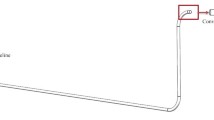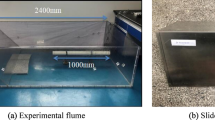Abstract
This study proposes a new approach in which an impermeable plate is placed under the pipeline to prevent the local scour around the pipeline. In order to understand the performance of this approach, the finite volume method (FVM) and volume of fluid (VOF) method are adopted to simulate the flow field around the pipeline. The pressure distribution along the sandy bed surface is obtained by considering the variation of water surface. Furthermore, the effects of water depth, unidirectional and bidirectional impermeable plates on pressure difference are discussed. The seepage flow field of sandy bed near underwater pipeline is numerically simulated using the laminar and porous media model. On this basis, the effect of the impermeable plate length on hydraulic gradient is investigated and the critical length of impermeable plate is obtained. The simulated results show that when the water depth is smaller than 5.00D (D is the diameter of pipeline), the effect of the water depth on the pressure difference is remarkable. The pressure differences between two endpoints of both the unidirectional and bidirectional plates decrease with the increase of the plate length. The variations of the pressure differences for both the unidirectional and bidirectional plates are similar. With the increase of plate length, the hydraulic gradient decreases and the piping at the seepage exit is avoided effectively as long as it reaches a certain length. Such a critical length of the plate decreases with the increase of the water depth. When water depth is larger than 4.00D, the effect of the water depth on the critical length is small. For the same water depth, the critical length of impermeable plate increases with the increase of the dimensionless flow parameter. Numerical simulation results are in good agreement with the available experimental measurements.
Similar content being viewed by others
References
Mao Y. The interaction between a pipeline and an erodible bed. Dissertation of Doctoral Degree. Denmark: The Technology University of Denmark, 1986
Sumer B M, Jensen H R, Fredsøe J. Effect of lee-wake on scour below pipelines in current. J Waterw Port C-ASCE, 1988, 114: 599–614
Moncada-M A T, Aguirre-Pe J. Scour below pipeline in river crossings. J Hydraul Eng-ASCE, 1999, 125: 953–958
Subhasish D, Navneet P S. Clear-water scour depth below underwater pipelines. J Hydro-Environ Res, 2007, 1: 157–162
Yang L P, Shi B, Guo Y K, et al. Calculation and experiment on scour depth for submarine pipeline with a spoiler. Ocean Eng, 2012, 55: 191–198
Van Beek F A, Wind H G. Numerical modeling of erosion and sedimentation around pipelines. Coast Eng, 1990, 31: 107–128
Brørs B. Numerical modeling of flow and scour at pipelines. J Hydraul Eng-ASCE. 1999, 125: 511–523.
Li F, Cheng L. A numerical model for local scour under offshore pipelines. J Hydraul Eng-ASCE, 1999, 125: 400–406
Liang D F, Cheng L, Li F. Numerical modeling of scour below a pipeline in currents. Part II: Scour Simulation. Coast Eng, 2005, 46: 43–62
Gao F P, Yang B, Wu Y X, et al. Steady current induced seabed scour around a vibrating pipeline. Appl Ocean Res, 2006, 28: 291–298
Sun J W, Geng H, Sun Z C. Numerical model for local scour around offshore pipelines (in Chinese). Ocean Tec, 2010, 29: 51–55
Chiew Y M. Mechanics of local scour around submarine pipelines. J Hydraul Eng-ASCE, 1990, 116: 452–466
Sumer B M, Truelsen C, Sichmann T. Onset of scour below pipelines and self-burial. Coast Eng, 2001, 42: 313–335
Guo Y K, Wang P, Zhou H J. Modelling study of the flow past irregularities in a pressure conduit. J Hydro Eng-ASCE, 2007, 133: 698–702
Guo, Y K, Zhang J S, Zhang L X. Numerical simulation of 3D flow around an overlapping cylinder. Maritime Eng-ICE, 2010, 163: 49–56
Yang B, Gao F P, Wu Y X, et al. Numerical study of the occurrence of pipeline spanning under the influence of steady current (in Chinese). Shipbuild China, 2005, 46: 221–226
Zang Z P, Cheng L, Zhao M, et al. A numerical model for onset of scour below offshore pipelines. Coast Eng, 2009, 56: 458–466
Gao F P, Luo C C. Flow-pipe-seepage coupling analysis of spanning initiation of a partially-embedded pipeline. J Hydrodyn, 2010, 22: 478–287
Han Y, Shi B, Ren X Y, et al. Experimental study on the function of spoilers in protecting submarine pipeline (in Chinese). J Sichuan Univ (Eng Sci Edi), 2010, 42: 100–106
Yang L P, Guo Y K, Shi B, et al. Study of scour around submarine pipeline with a rubber plate or rigid spoiler in wave conditions. J Waterw Port C-ASCE, 2012, 138: 484–490
Author information
Authors and Affiliations
Corresponding author
Rights and permissions
About this article
Cite this article
Zhang, Z., Shi, B., Guo, Y. et al. Numerical investigation on critical length of impermeable plate below underwater pipeline under steady current. Sci. China Technol. Sci. 56, 1232–1240 (2013). https://doi.org/10.1007/s11431-013-5194-5
Received:
Accepted:
Published:
Issue Date:
DOI: https://doi.org/10.1007/s11431-013-5194-5




